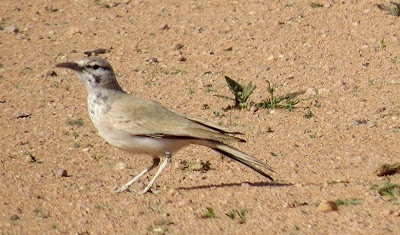This type of birding is hard work as you can go for long periods off-road without seeing any bird at all. In our case after over six hours we came across five species of lark.
Temminck's lark
Most of the landscape was stony or compacted sand desert and semi-desert. The area near Rumah itself was overgrazed by camels and mostly loose sand with only the poisonous apple of sodom as vegetation. It was completely degraded and useless for our purposes as well as very difficult to drive in. However the other areas held prospects.
Contrary to popular belif, we found most larks near the greener patches where recent rains had produced some growth.
This was true of the four Temminck's lark that we encountered.
Hoopoe lark
Although there is lots of overlap, each lark species has slightly different preferences for habitat. Hoopoe lark can tolerate even drier areas than most. However even this lark was seen near temporary greenish areas albeit surrounded by what looked like pure desert.
Bar-tailed lark
Bar-tailed lark likes compacted sandy areas which are very flat and that is exactly where we found a flock. As usual they were highly mobile and running.
crested lark (courtesy of Bernard Bracken)
Even out here the most common lark are crested lark followed by desert lark. They were easily seen by the road side in all terrains for the former and in hilly terrains for the latter.
desert wheatear
No Dunn's lark were seen. They prefer some low lying scrub and unfortunately the camels have destroyed these. I suspect private land where camels aren't allowed are the best bet for this species in this area.
Three types of wheatear were come across while looking for larks. These were desert wheatear, Isabelline wheatear and Eastern mourning wheatear.
Isabelline wheatear
Desert wheatear was the most frequently seen.
Eastern mourning wheatear
A few other species were observed. House sparrow were found in one wadi with a road bridge. Two kestrel were observed on look outs in the desert.
steppe eagle
Several steppe eagle were seen on the way out of Riyadh to the escarpment and two were found in the desert itself. They had been attracted by six dumped sheep carcasses in the middle of nowhere. Sadly there were no vultures with them. This is yet another piece of evidence that vultures are no longer found north of Riyadh (to the west and south west there are wintering Griffon vulture) and in particular the Egyptian vulture population here has extirpated.
The other species in the area is pale crag martin. This are best seen next to any piles of rubbish where the flies attract them.
I am going to try my luck with more desert birding on Friday when I'll be travelling 300 kilometres or so west out of Riyadh on the Mecca road. It's a new area for me but most of the target birds are long shots. Let's see.









No comments:
Post a Comment